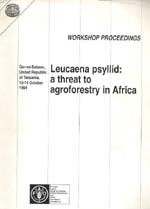 |
WORKSHOP PROCEEDINGS
Leucaena psyllid:
a threat to agroforestry in
Africa
Dar-es-Salaam, United Republic of Tanzania
10-24 October 1994
Organized by:
Tanzania Forest Research Institute (TAFORI)
In collaboration with:
Food and Agriculture Organization of the United Nations
USDA Forest Service
International Institute of Biological Control
International Centre for Research in Agroforestry
Sokoine University of Agriculture
|
FOOD AND AGRICULTURE ORGANIZATION OF THE UNITED NATIONS
Rome, 1995 |
Mention of trade names is for convenience only
and does not imply endorsement by the Food and
Agriculture Organization of the United Nations.
The designations employed and the presentation of material in this
publication do not imply the expression of any opinion whatsoever
on the part of the Food and Agriculture Organization of the United
Nations concerning the legal status of any country, territory, city or
area or of its authorities, or concerning the delimitation of its
frontiers or boundaries.
|
All rights reserved. No part of this publication may be reproduced, stored in a
retrieval system, or transmitted in any form or by any means, electronic,
mechanical, photocopying or otherwise, without the prior permission of the
copyright owner. Applications for such permission, with a statement of the
purpose and extent of the reproduction, should be addressed to the Director,
Publications Division, Food and Agriculture Organization of the United Nations,
Viale delle Terme di Caracalla, 00100 Rome, Italy.
© FAO 1995
TABLE OF CONTENTS
FOREWORD
OPENING STATEMENTS
TAFORI
FAO
USDA Forest Service
Opening address
Hon. Juma Hamad Omar (MP)
KEYNOTE ADDRESS
Worldwide Introductions of Forest Pests: An Update
W.M. Ciesla
OVERVIEW PAPERS
Importance of Leucaena in Africa
R. Otsyina and B. Dzowela
Effects of Leucaena Psyllid on Women's Enterprises
Asa Johansson
Integrated Pest Management of the Leucaena Psyllid: What is Involved?
J.D. Ward and J. Mwangi
COUNTRY REPORTS
BURUNDI
Leucaena Psyllid in Burundi
N. Pascal and K. Salvator
MOZAMBIQUE
Preliminary Observations on Leucaena Development on Mozambique
C.E. da Silva Ruas and R.M. da Trinidada Mária Rombe
KENYA
The Status of Leucaena Psyllid in Kenya
M. Gichora and J. Odera
MALAWI
The Status of Leucaena and Leucaena Psyllid in Malawi
C.Z. Chilima, G.S. Meke, L.A. Sitaubi and C. Coote
MAURITIUS
The Leucaena Psyllid in Mauritius
T. Rawanawshah
NIGERIA
Status of Leucaena in Nigeria
P.M. Papka
THE SUDAN
Forest Pests in the Sudan: Their Economic Importance and Control
H.A. El Atta and H.O. Abdel Nour
TANZANIA
Incidence of Forest Pests in Tanzania with a Special Reference to the Leucaena Psyllid
E.Z. Kisaka
SOUTH AFRICA
Possible
Occurrence of the European Wood Wasp, Sirex noctilio
(Hymenoptera:
Siricidae), in South Africa
G.
Tribe
ETHIOPIA
Leucaena
and Leucaena Psyllid in Ethiopia
T.
Azage
UGANDA
Leucaena Psyllid: A Threat
to Agroforestry in Africa: Uganda's Case
G. Maiteki, P. Kiwuso and
W. Kigenyi
ZAMBIA
Distribution
of Leucaena, Current Status and Impact of
Leucaena Psyllid and Some Management Options in Zambia
O. Shakacite
ZIMBABWE
Status of
Leucaena and Leucaena Psyllid in Zimbabwe
A.N.
Mphuru
PEST MANAGEMENT METHODS - LEUCAENA PSYLLID
Leucaena
Psyllid in the Asia-Pacific Region: Implications
for its Management in Africa
Banpot Napompeth
Leucaena Psyllid in Kenya and Experience
with Chemical Control
M.R. Rao
First
Results on Leucaena diversifolia Buitenzorg Resistance to
Leucaena Psyllid (Heteropsylla cubana) in Réunion
J. Tassin
and M. Hermet
Successful
Establishment on Réunion Island of an Exotic Ladybird,
Olla v-nigrum, for the Biocontrol of Leucaena Psyllid,
Heteropsylla cubana.
S. Quilici, A. Francki, B. Montagneux and
J. Tassin
Periodicity
of Leucaena Psyllid Infestation on Leucaena leucocephala in Morogoro: Preliminary Observations
S.S. Madoffe and A. Massawe
Apparent
Opposing Biological Control Strategies: Protecting
Leucaena leucocephala While Curbing its Invasiveness
G.D.
Tribe
Indigenous Natural Enemies of Leucaena
Psyllid in Kenya
C.K.P.O. Ogol
Candidate Agents for Biological Control of
Leucaena Psyllid in Africa
R. Day, G. Hill, S. Murphy and B. Nyambo
PEST MANAGEMENT METHODS - OTHER PESTS
The Kenya
Integrated Forest Pest Management Centre: Mission, Goals and Future
Plans
J.G. Mwangi and J.G.D. Ward
The
International Institute of Biological Control's (IIBC)
Regional
Programme for Biological Control of Exotic Conifer Aphids in Africa
G.B.
Allard, S.T. Murphy and R.K. Day
Pest Introductions in the United States
and How They Are Being Addressed
D.R. Kucera, R.D. Wolfe and G.D. Hertel
INFORMATION SHARING
Concept
Document for the Formation of an Eastern and Southern African Forest
Pest Management Network
G.B.
Allard
Working Group Reports
CONCLUSIONS AND RECOMMENDATIONS
Conclusions
Recommendations
Closing
Remarks
F.M. Shao
PHOTOGRAPHS
LIST OF PARTICIPANTS
